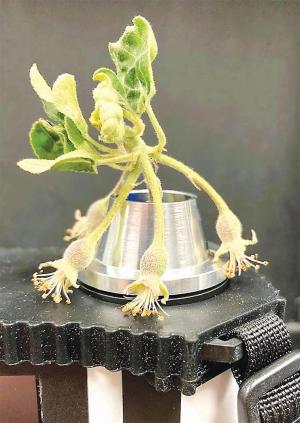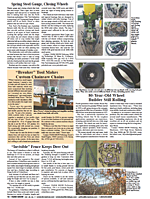Technology Holds Promise For Apple Orchard Thinning
 ✖  |
Apple growers often use chemical sprays to thin their trees and reduce flower numbers. Without intervention, trees will produce too many flowers, resulting in small, unmarketable fruit. Chemical thinning boosts apple size and quality, helping to maintain crop consistency.
The grower’s challenge is assessing how effective thinning is after spraying, since often, additional applications are needed.
Former North Carolina State University researcher Jimmy Larson recently completed trials using a handheld spectrometer to predict fruitlet abscission potential and provide more accurate thinning spray information. The research was conducted under the guidance of NC State Assistant Professor Tom Kon.
“We used a Felix hand-held spectrometer at harvest to determine the brix and dry matter content of fruitlets,” Larson says. “We used this information to predict abscission. The goal was to identify how many fruitlets will fall off, so growers will have a more precise idea of the numbers desired at harvest.”
To measure the fruitlets with the spectrometer, fruitlets were placed calyx end down on the lens. A beam of light was directed at the fruitlet, which absorbed it and reflected it to the meter. The meter measured the light reflectance in the visible and near-infrared portions of the light spectrum to estimate factors such as chlorophyll and water content.
The trials began in 2021 and were completed in 2023 using numerous apple varieties from orchards in North Carolina, New York and Michigan.
Data indicated that persisting fruitlets displayed lower reflectance, were typically larger, contained more chlorophyll, and absorbed more light compared to abscising fruitlets. They also showed higher estimated water content.
The team compared their findings to the standard fruitlet growth rate model, which tracks changes in fruitlet diameter over time. Although accurate, this method is labor-intensive, requiring repeated caliper measurements, and in the Southeast, it only predicts fruit set about nine days after spraying. A technique using a single sampling period and a spectrometer could provide earlier thinning predictions and be more practical. Currently, farmers rely on their experience, fruit growth or size distribution models, and visual cues like coloration, which appear roughly 14 days after thinning.
The Felix meter’s prediction accuracy exceeded 90% within three days of application.
“Of course, the main drawback of this technology is that we can only measure a single fruitlet at a time,” Larson explains. “To make a real advancement, we need an engineer or an automation company to take the findings and develop the technology into something more efficient, like a small tractor or ATV-mounted camera system to drive throughout the orchard and collect rapid measurements. Hopefully, something like this can become a reality.”
Contact: FARM SHOW Followup, Jimmy Larson, Assistant Professor, Utah State University, 4820 Old Main Hill, Logan, Utah 84322 (j.larson@usu.edu).

Click here to download page story appeared in.
Click here to read entire issue
Technology Holds Promise For Apple Orchard Thinning
Apple growers often use chemical sprays to thin their trees and reduce flower numbers. Without intervention, trees will produce too many flowers, resulting in small, unmarketable fruit. Chemical thinning boosts apple size and quality, helping to maintain crop consistency.
The grower’s challenge is assessing how effective thinning is after spraying, since often, additional applications are needed.
Former North Carolina State University researcher Jimmy Larson recently completed trials using a handheld spectrometer to predict fruitlet abscission potential and provide more accurate thinning spray information. The research was conducted under the guidance of NC State Assistant Professor Tom Kon.
“We used a Felix hand-held spectrometer at harvest to determine the brix and dry matter content of fruitlets,” Larson says. “We used this information to predict abscission. The goal was to identify how many fruitlets will fall off, so growers will have a more precise idea of the numbers desired at harvest.”
To measure the fruitlets with the spectrometer, fruitlets were placed calyx end down on the lens. A beam of light was directed at the fruitlet, which absorbed it and reflected it to the meter. The meter measured the light reflectance in the visible and near-infrared portions of the light spectrum to estimate factors such as chlorophyll and water content.
The trials began in 2021 and were completed in 2023 using numerous apple varieties from orchards in North Carolina, New York and Michigan.
Data indicated that persisting fruitlets displayed lower reflectance, were typically larger, contained more chlorophyll, and absorbed more light compared to abscising fruitlets. They also showed higher estimated water content.
The team compared their findings to the standard fruitlet growth rate model, which tracks changes in fruitlet diameter over time. Although accurate, this method is labor-intensive, requiring repeated caliper measurements, and in the Southeast, it only predicts fruit set about nine days after spraying. A technique using a single sampling period and a spectrometer could provide earlier thinning predictions and be more practical. Currently, farmers rely on their experience, fruit growth or size distribution models, and visual cues like coloration, which appear roughly 14 days after thinning.
The Felix meter’s prediction accuracy exceeded 90% within three days of application.
“Of course, the main drawback of this technology is that we can only measure a single fruitlet at a time,” Larson explains. “To make a real advancement, we need an engineer or an automation company to take the findings and develop the technology into something more efficient, like a small tractor or ATV-mounted camera system to drive throughout the orchard and collect rapid measurements. Hopefully, something like this can become a reality.”
Contact: FARM SHOW Followup, Jimmy Larson, Assistant Professor, Utah State University, 4820 Old Main Hill, Logan, Utah 84322 (j.larson@usu.edu).
To read the rest of this story, download this issue below or click
here to register with your account number.







